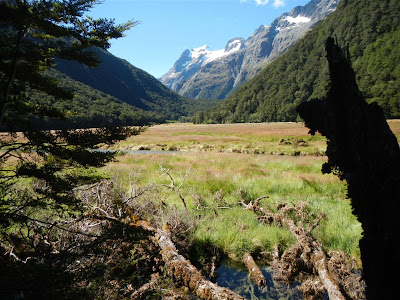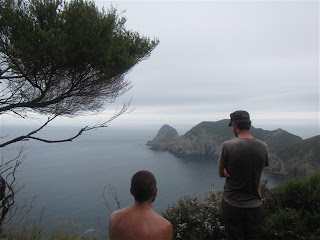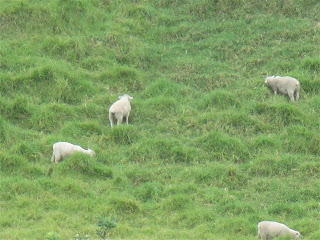It only really sank in how long it's
been since I've written anything when I finally slowed down after my
brother left. He took off from Waiheke two weeks ago and I've been
hopping around anchorages here ever since. I'm not going to lie, it
feels pretty good to be relatively stationary.
 Ardea took us on a glorious tour of
Great Barrier Island. We hit at least a dozen anchorages on the whole
of the west coast, climbed the highest peak, hiked to the hot
springs, which were too hot to touch in some places, much less to
engage in any sort of prolonged bathing. One of the highlights was
Smokehouse Bay, where a Kiwi fellow left the land and money for some
facilities in one small bay. There are several large fish smokers,
concrete basins with hand-crank washing fixtures, and a couple of
baths, one indoors and one outdoors. The baths could be filled with
piping hot water as long as one makes a little fire in the nearby
iron stove. On top of it all, there was an excellent cockle beach
nearby; cockles are a type of clam that burrow in shallow, sandy
areas. We went at low tide with our friend Al and came back with
heaps of them.
Ardea took us on a glorious tour of
Great Barrier Island. We hit at least a dozen anchorages on the whole
of the west coast, climbed the highest peak, hiked to the hot
springs, which were too hot to touch in some places, much less to
engage in any sort of prolonged bathing. One of the highlights was
Smokehouse Bay, where a Kiwi fellow left the land and money for some
facilities in one small bay. There are several large fish smokers,
concrete basins with hand-crank washing fixtures, and a couple of
baths, one indoors and one outdoors. The baths could be filled with
piping hot water as long as one makes a little fire in the nearby
iron stove. On top of it all, there was an excellent cockle beach
nearby; cockles are a type of clam that burrow in shallow, sandy
areas. We went at low tide with our friend Al and came back with
heaps of them. |
| Mmmmm. Cockles and boxed wine... |
 |
| A Tuerto mission to the mussel farms... |
 |
| Was a shame Chuck brought the same Topsiders as I have. It was such a tough time figuring out whose were whose. |
 |
| Ardea in Tryphena Bay at Great Barrier. Coromandel Penninsula in the background. |
 |
| Kauri, the famous NZ hardwood, rises above the falls on GBI. |
 |
| Hiking to the hot springs. |
We spent around two weeks out there.
Dianna left from Port Fitzroy and Charlie and I continued South,
eventually jumping from Barrier to Colville Harbor on the Coromandel
Peninsula, where we met some comical characters enjoying their
vacation double-wides on the beach at Otautu Bay. It made for a
pretty hilarious night.
We moseyed on down the Penninsula to
Coromandel Town, where we met some more fine folk and spent several
days. It's a nice town there, like Sausilito or Fairfax except more
country, whatever that means to you. We rented a car there and
explored the east coast of the Coromandel. We had a few hikes, tried
to get a little surf, and ended the day at Hot Water Beach. There are
hotsprings at one end of the beach that you can access by digging a
hole in the sand at low tide. If you hit the right spot, the hole
will backfill with super hot water. It was pretty righteous, sitting
with the waves splashing into the sandy hot tubs scattered about.
There were lots of people, but it didn't matter.
Finally we sailed over to Waiheke
Island and visited Jon and Nia at the winery that they've been
employed with for a few months. A day or two later, Chuck took off,
and I had no further plans nor excuses for avoiding them. Still, I've
had Jon and Nia, Claus and Tim, and new friends to hang out with.
Chittick came up for a visit, too, and we reminisced and went
kiteboarding and drank plenty of beers. It was a grand old time, but
we both agreed we miss America. Still, I'll keep fishing and scallop
diving and living it up the sailor way right up until it's time to
leave.
On that, after much deliberation, I
assure you, I decided to put Ardea on TradeMe, the kiwi sort of eBay
deal, and head back to California. I thought about sailing back via
the southern route to Tahiti then Hawaii, or heading to Fiji or
Australia, but then I'd just as soon go back and start again. And,
yeah, I've got three-foot-syndrome, but it's not just about getting a
bigger boat in California. I'm getting pretty damned close to
ten-thousand miles over ground on this little boat and the most
consistent thing I felt about it all was how much I'd like to be
studying the sea; will I someday sail myself to remote research
locations? Can't know for sure, but I think I'll have a go at making
something like that happen. In any case, I'm far from finished
sailing and I feel I can start again with all the wisdom I've gained
on this trip and have a much easier time of it. Mexico? Well that's
pretty damned close by now, isn't it?
In some ways it seems ridiculous to
leave Ardea now. After all we've been through and after all the work
I've put into her, I'm sort of only just finally settled in. I mean
that boat is pretty much dialed in. I know how to run it and I know
everything that's good and bad and squirrely and quirky and
everything else. I know exactly what I've got and I can fix any of
it. So what's my rationale? Shit, it seems like I'm still sort of
working on it. This whole thing has been challenging. Even up to now,
trying to sell the boat, I'm learning every day. And that's exactly
what I wanted. Sailing back to the tropics is very, very tempting,
but I feel like I would like something to do once I get there, aside
from all of the obvious and, admittedly, enjoyable activities that
I've been doing for the entirety of this endless summer. So, anyway,
it's back home with this sailor, looking for new challenges, with
some new ideas, some new goals and, before too long, I'm sure, a new
boat.
I'll be back in the Bay in a month or
so, looking for some work and starting to figure out how to get to
graduate school. I'm pretty excited for some change, though the
thought of parting with this boat that has been so good to me brings
me great sadness.
This site will stay up and there's a
lot of things I'd like to share up here. I'll post from time to time,
especially once I'm back in California and can do some video editing
and use high-speed internet. In the meantime, I'd love to hear from
whoever is out there and reading about this little adventure. This
blog has been around for a little over a year and has 25,000 hits
from mainly the U.S., but also several countries in Asia, lots of
hits from the Ukraine, Poland, Germany, Australia, India, F.P., NZ,
Russia, France, Lithuania... okay, only six hits from Lithuania, but
still, it's pretty crazy to me.
At some point I'm sure I'll go back and
read all of this blabber, as it will be interesting to see how it
evolved. My mental space has probably been more apparent than I may
have realized while writing, and it has changed so much throughout
the vicissitudes of seafaring. It is still strange for me to think
about that knowing that I post this stuff where anybody can read it,
and it's probably pretty clear that I've become more comfortable with
that over time. In any case, for those who read this or any of my
rambles, whether one line or every line, thanks for your patience.
For the minority who like the long, wordy stories, I may well have a
yarn or two left. For now, though, I'll share a short verse that has
always inspired me and leave you with some photos of beautiful New
Zealand.
I read this in a National Geographic
years ago. It was written by C. Day Lewis.
Those Himalayas of the mind
Are not so easily possessed
There's more than precipice and
storm
Between you and your Everest
 |
| Threatened brown teals at Great Barrier Island. |
 |
| Pilot whales breaching just off the bow near Whangaparapara Bay, GBI. |
 |
| Trekking the fjord lands of South Island. |
 |
| Along the Routeburn Track, South Island |
 |
| Routeburn Flats Campsite, South Island. |
 |
| Not a bad view... |
 |
| Routeburn Track- approaching the Divide. |
 |
| Lake Howden, Routeburn Track, South Island. |
 |
| View from Mount Hobson, Great Barrier Island. |
 |
| Dolphins in Whangaparapara Bay, GBI. |
 |
| Ardea sails on. |


.JPG)
.JPG)
.JPG)
.JPG)
.JPG)
.JPG)
.JPG)
.JPG)
.JPG)
.JPG)
.JPG)
.JPG)
.JPG)
.JPG)
.JPG)
.JPG)
.JPG)
.JPG)
.JPG)
.JPG)











